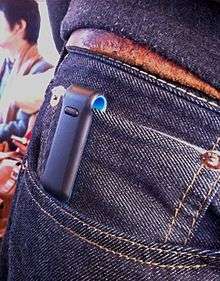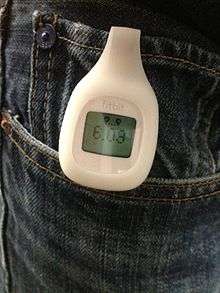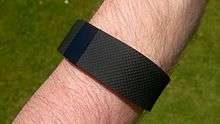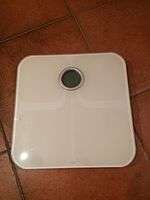List of Fitbit products
This is an incomplete list of Fitbit products that American consumer electronics company Fitbit has released.
Products
Fitbit Tracker

The Fitbit Tracker was a small black and teal device that could be clipped discreetly onto clothing and worn 24/7. It uses a three-dimensional accelerometer, similar to that in the Wii Remote, to sense user movement. The Tracker measures steps taken, and combines it with user data to calculate distance walked, calories burned, floors climbed and activity duration and intensity. It uses an OLED display to display this and other information such as the battery level. It also measures sleep quality by tracking periods of restlessness, how long it takes the wearer to fall asleep and how long they are actually asleep.[1]
A wireless base station is included to receive data from the Tracker and to charge its battery. When connected to a computer, the base station will upload data to the Fitbit website, where a number of features are available: seeing an overview of physical activity, setting and tracking goals, keeping food and activity logs and interacting with friends. Use of the website is free.
The Fitbit Classic tracked only steps taken, distance traveled, calories burned, activity intensity and sleep.
At the TechCrunch50 during the "Mobile" session on September 9, 2008,[2] Fitbit received positive reactions during its panel from experts like Rafe Needleman, Tim O'Reilly, and Evan Williams who cited its wearability, price, and lack of subscription fees.
Fitbit Ultra
A hardware upgrade called the Fitbit Ultra was announced on October 3, 2011.[3] The new features included:
- an altimeter that measures elevation gain in terms of floors, with one floor roughly equivalent to ten feet
- a digital clock visible on the device's display
- a stopwatch that can be used to time activities
- randomized "Chatter" messages show when the Ultra is moved after sitting idle for a while, and there's a custom field to write in a personal "Greeting".
- new colors (plum or blue, as opposed to the original teal)
The Fitbit Ultra is powered by a small lithium polymer battery.[4]
The Fitbit Ultra suffered from a small design flaw: the unit had a permanently curved shape in order to clip directly onto any piece of clothing. The plastic used in the unit was not appropriate for the strain experienced at the looped end, and with time would become brittle, and crack. While most users experienced only minor cracking with no effects to the device's function, in a few cases the cracking led to total failure: mostly the case splitting and screen ceasing to function.[5][6][7] Fitbit offered replacement or repair of affected units, under warranty.
Fitbit One

Announced on September 17, 2012, the Fitbit One is an update to the Fitbit Ultra that uses a more vivid digital display, has a separate clip and a separate charging cable and wireless sync dongle.[8] The Fitbit One and the Fitbit Zip were the first wireless activity trackers to sync using Bluetooth 4.0 or Bluetooth SMART technology. The wireless syncing is currently available on iOS and Android devices such as the iPhone 4S and higher, iPad 3rd generation, iPod touch 5th generation, Samsung Galaxy Note II and higher, Samsung Galaxy S III and higher, LG G2, HTC One, Moto X, and Nexus 4 or higher.[9] Fitbit One can record several daily activities, including but not limited to, number of steps taken, distance travelled on foot, number of floors climbed, calories burned, vigorously active minutes, sleep efficiency, delicate movements during sleep, number of wake-ups during sleep, etc.
Fitbit Zip
Announced on September 17, 2012, the Fitbit Zip is roughly the size of a United States quarter and tracks only steps taken, distance traveled, and calories burned. Compared to the other Fitbit trackers, the Zip is the first Fitbit product to include a disposable battery. It is priced cheaper than other Fitbit trackers. Similar to the Fitbit One, it is able to sync its data wirelessly to supported mobile devices, such as the iPhone 4S and higher, iPad 3rd generation, iPod touch 5th generation, Samsung Galaxy Note II and higher, Samsung Galaxy S III and higher, LG G2, HTC One, Moto X, and Nexus 4 or higher.[9]
Fitbit Flex


In May 2013, Fitbit released the Fitbit Flex, which is worn on the wrist. It tracks movement 24 hours a day, including sleep patterns. It has a simple display of 5 LED lights that indicate the number of steps walked in a day, and it vibrates to indicate when the wearer's goal has been reached. The lights also indicate battery level. The Fitbit Flex has almost all the same sync functions as the Fitbit One and Zip. The Flex is the most water-resistant tracker, though cannot be worn while swimming.[10] It includes a specialized USB charger; the battery lasts 5–7 days, and it takes 1–2 hours to charge.
Fitbit Force
The Fitbit Force was announced on October 10, 2013. It has an OLED display[11] that shows time and daily activity. The Force tracks a number of statistics in real-time, including steps taken, distance traveled, calories burned, stairs climbed and active minutes throughout the day. At night, the Force tracks sleep and can wake a user silently with a vibrating alarm.
On January 13, 2014 it was reported that an unconfirmed number of Fitbit customers had complained about skin irritation after wearing the Force for extended periods of time.[12] Fitbit stated on its website that the company consulted with medical professionals whose assessments are that these irritations are most likely allergic reactions to nickel, a component of the surgical-grade steel or the adhesives used to assemble the Fitbit Force.[13] Fitbit, working with the Consumer Protection Safety Commission, recalled the Fitbit Force on February 20, 2014.[13] On March 12, 2014 the Consumer Product Safety Commission (CPSC) made the recall official.[14] At that time it was revealed that The Fitbit Force had caused about 9,900 injuries.[14] It is no longer for sale on Fitbit's website.
Fitbit Charge
Announced in October 2014, the Fitbit Charge is a replacement for the Fitbit Force. It was released in November 2014 for US$130 retail. Unlike the Force, Charge's wrist band is textured and can display caller ID information from a connected smartphone through the Fitbit app. The Charge automatically tracks users' steps, sleep, flights of stairs (using an altimeter) and an approximation of distance traveled. It tracks steps using a 3 axis accelerometer by tracking forward movement along with slight upwards through movements. Both the Charge and the HR version register each step almost exactly half through the step.[15][16]
Fitbit Charge HR

Announced in October 2014 and released in early January 2015, the Charge HR is the Charge plus a heart-rate monitor and a calorie counter. With this addition the 7-day battery life is reduced to 5 days. The Charge HR has the same textured band as the Charge and comes in black, plum, blue, tangerine, pink, and teal colors. The Charge HR band clasp resembles that of a traditional watch instead of the snap-on band of the original Charge.[17][18][19]
Fitbit Surge
Announced in October 2014, the Surge is like a smartwatch as well as an activity tracker and aimed for the fitness demographic. It includes a heart-rate monitor and the ability to track pace, distance, and elevation using the GPS on the device. The Surge also can send alerts of text and incoming calls from a connected smartphone.
Fitbit Aria

In April 2012,[20] Fitbit released a weighing scale called the Fitbit Aria. It recognizes users who are wearing Fitbit trackers and measures weight, body mass index (BMI) and percentage of body fat of the user. It can keep track of eight individual users and updates information to fitbit.com automatically via Wi-Fi network.[21] The information is also updated to the mobile apps.
Fitbit Blaze
At the CES event in January 2016,[22] Fitbit announced a fitness watch called "Fitbit Blaze". It is similar to a modern smart-watch, such as Apple Watch, Pebble Smart-watch, and Android Wear watches. The Blaze focused on fitness first, then smart features inside the watch. Unlike the Surge, the Blaze comes with a colored touchscreen, and exchangeable strap and frame. Some functionality from the Surge has been retained, such as auto-tracking exercise and heart-rate monitor. Blaze has connected GPS,[23] meaning it can track movements by using the connected smartphone's GPS. The user can receive notifications, including incoming calls, texts and calendar appointments on the Blaze.[24]
The Fitbit Blaze also integrates with Fitstar, Fitbit's website for customized workouts. These workouts can be displayed on the Blaze's screen.[25]
Fitbit Alta
The Fitbit Alta[26] has the features of standard Fitbit wristbands, but lacks heart rate monitoring and an altimeter, so it does not track flights of stairs. It can be used for tracking exercises and sleep. The wristband offers a full OLED touchsreen that you can tap to see your reminders, a clock and smartphone notifications. The Alta is also able to recognize the type of activity you are doing: running, playing football, or just walking. It also tracks active minutes.
Fitbit Charge 2
The Fitbit Charge 2 has many similar features as the Charge HR, which it replaced. It features the new PurePulse Technology, a newer and enhanced heart rate monitoring system which allows for more accuracy. The complete design change resembles that of the Fitbit Surge Being slightly slimmer than the Surge itself. The design features a larger screen as well. It also enables you to change the wristband.
Fitbit Flex 2
The Fitbit Flex 2 has many of the same features as the Fitbit Flex, now completely waterproof tracker. It is the slimmest Fitbit to date, with the original Flex dots, now vertical. The Fitbit Flex 2 can track swimming.
References
- ↑ Ewalt, David M. (June 11, 2010). "Getting Fitbit". Forbes. Retrieved September 22, 2015.
- ↑ Greene, Kate (September 10, 2008). "Self Surveillance". Technology Review. Massachusetts Institute of Technology. Retrieved September 19, 2009.
- ↑ "Fitbit Blog". Fitbit Blog.
- ↑ "Fitbit Ultra". takeitapart.com.
- ↑ "Fitbit Ultra Repair". www.fatguyshrinking.com. Retrieved 2015-12-28.
- ↑ "Fitbit! In which I switch from my failing Fitbit Ultra to a Fitbit One, with error messages.". azurelunatic.dreamwidth.org. Retrieved 2015-12-28.
- ↑ "Fitbit One Review". Technically Running. Retrieved 2015-12-28.
- ↑ Wilson, Mark. "Fitbit's Newest Gadget: 24/7 Fitness Tracking Meets 24/7 App Syncing". Co.Design. Fast Company. Retrieved 26 January 2013.
- 1 2 "Fitbit Supported Devices". fitbit.com.
- ↑ "Fitbit Flex Wireless Activity & Sleep Wristband – Specifications". Fitbit.
Flex has been tested up to 1 ATM meaning it is sweat, rain and splash proof. However, the device is not swim proof.
- ↑ "The best activity tracker yet... The Fitbit Force reviewed".
- ↑ "Fitbit Apologizes To Customers Who've Experienced Skin Reactions". The Huffington Post.
- 1 2 CEO letter 2/20/14. February 20, 2014.
- 1 2 "Fitbit Recalls Force Activity-Tracking Wristband Due to Risk of Skin Irritation". U.S. Consumer Product Safety Commission. 12 March 2014.
- ↑ Burns, Matt (October 27, 2014). "Fitbit's Latest Activity Trackers Feature Heart Monitoring, Smartwatch Functions". TechCrunch.
- ↑ Two Surprises in Fitbit's New Charge Fitness Tracker, CIO.com, November 25, 2014
- ↑ "Fitbit Charge HR Wireless Heart Rate + Activity Wristband". fitbit.com.
- ↑ Burns, Matt. October 27, 2014 "Fitbit's Latest Activity Trackers Feature Heart Monitoring, Smartwatch Functions" TechCrunch.
- ↑ "Fitbit Charge HR".
- ↑ "Fitbit". Engadget.
- ↑ "Fitbit Aria™ Wi-Fi Smart Scale". fitbit.com.
- ↑ Goode, Lauren (January 5, 2016). "Fitbit's new wearable is a fitness watch called Blaze". The Verge.
- ↑ "CES 2016 highlights". Techvedic.
- ↑ Cipriani, Jason (March 29, 2016). "Getting started with the Fitbit Blaze". CNET.
- ↑ Stables, James (March 3, 2016). "Fitbit Blaze review". Wareable.
- ↑ "Fitbit has announced a customizable fitness band – the Alta". gadgetswizard. February 4, 2016.